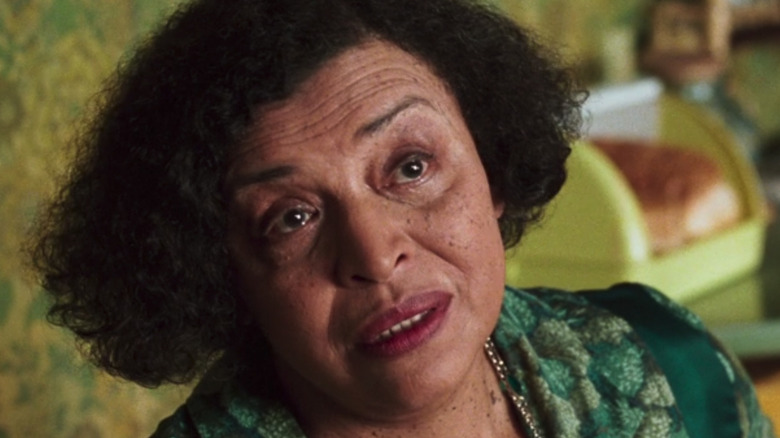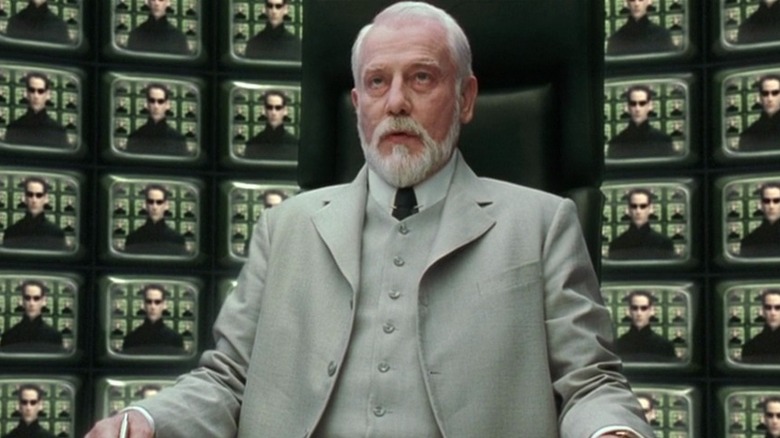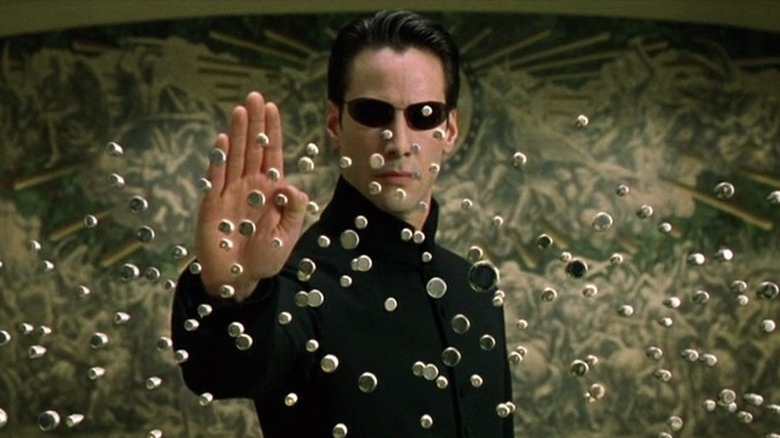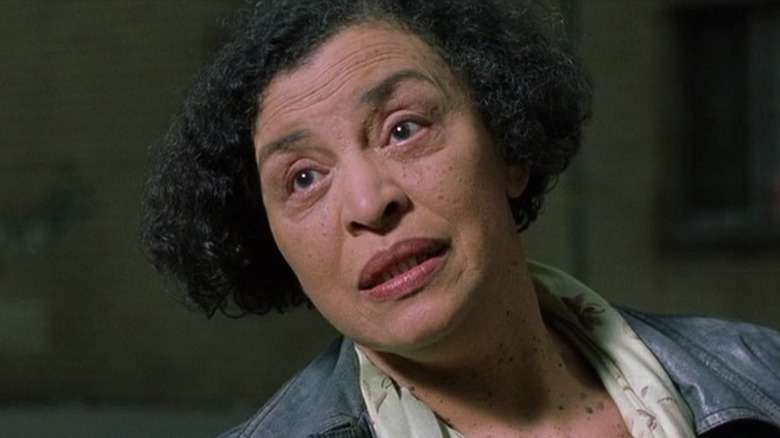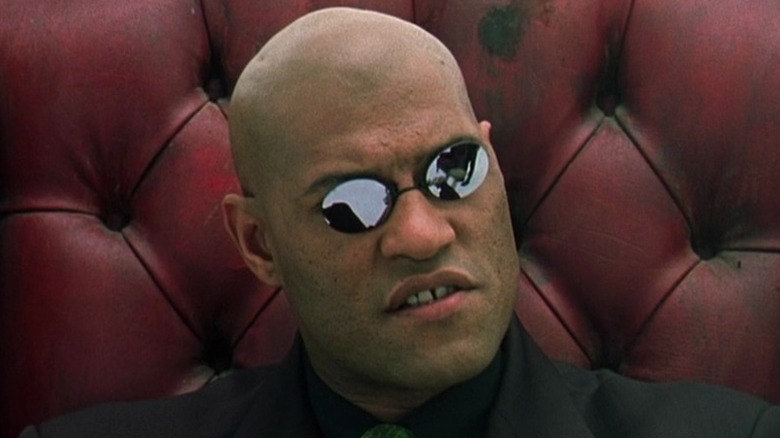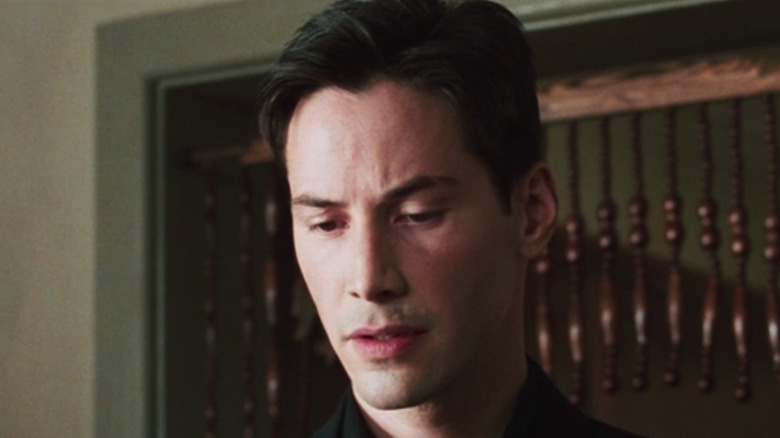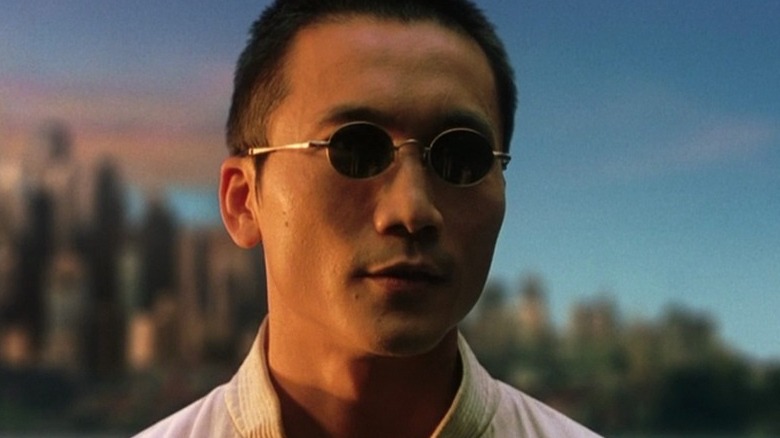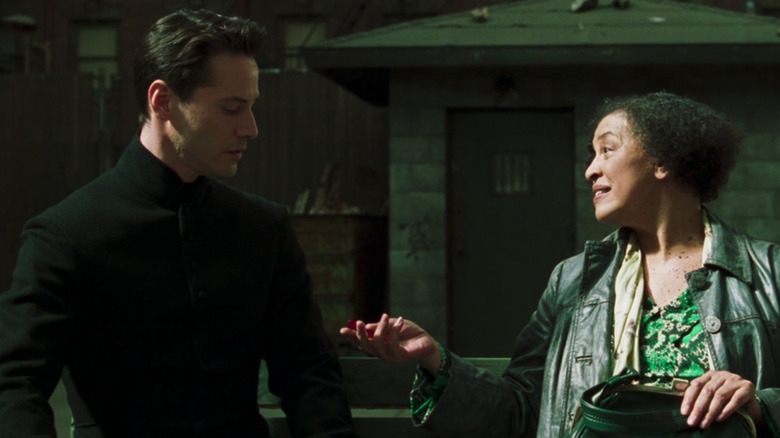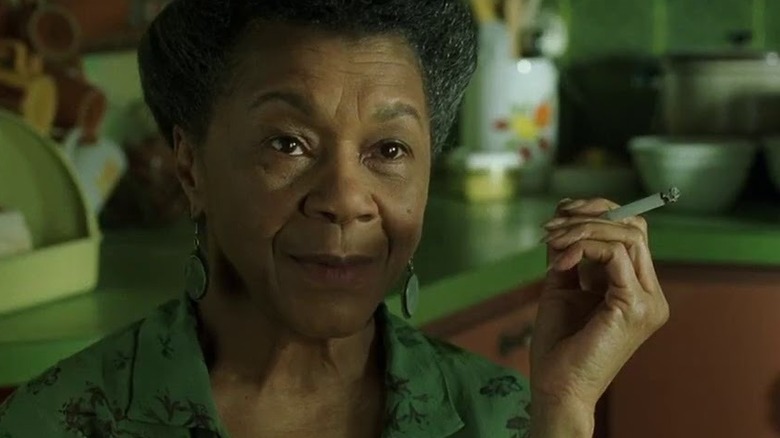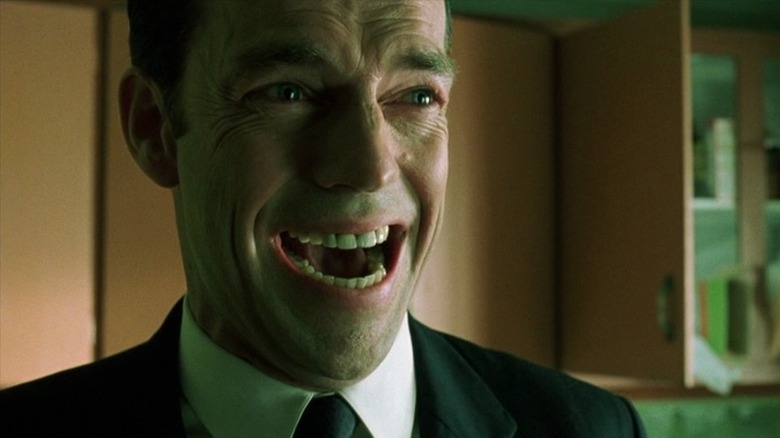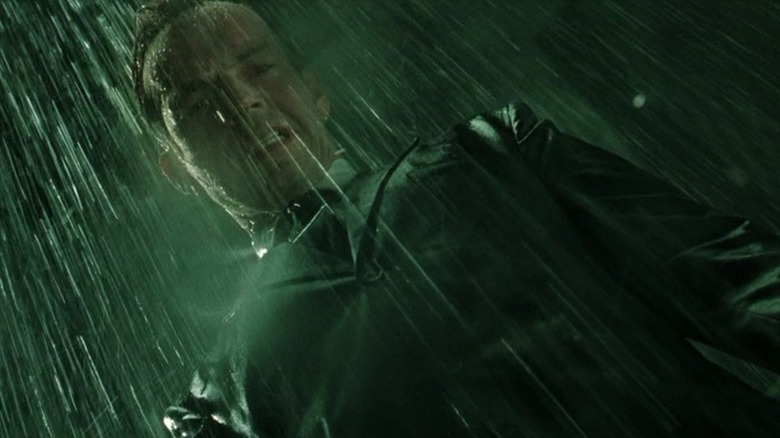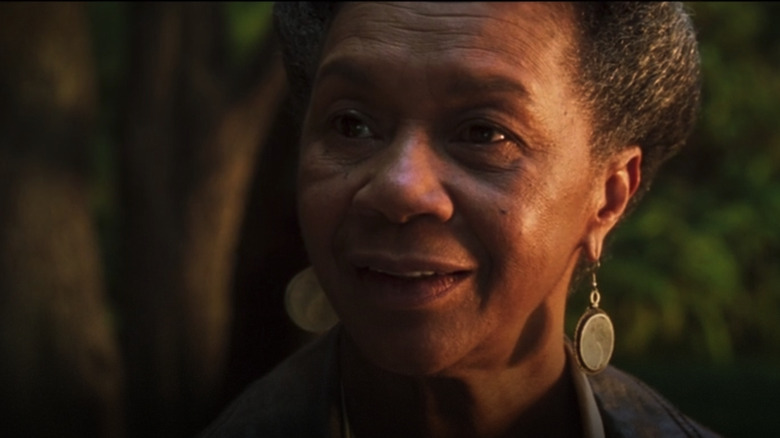The History Of The Oracle In The Matrix Explained
In a fantasy story about a hero with a special destiny, it's not uncommon for our apparent "chosen one" to encounter a character who can see the entire journey ahead of them and offer them a few hints without giving too much away. This appears to be the role of "the Oracle," the wise old lady visited by Neo in 1999's "The Matrix." The Oracle appears in only one scene of the film, amounting to five very memorable minutes of screen time. When the story was expanded into a trilogy, the Oracle's role grew with each subsequent film, gradually revealing that she's got a much larger role to play in the story than simply offering some friendly advice. While she remains, superficially, just a fountain of exposition for the benefit of the protagonists Neo, Morpheus, and Trinity, she's actually a very interesting and important character with her own history and motivations.
The Oracle doesn't only see the future; she makes the future, both by her action and inaction, guiding the fates of protagonists and antagonists alike. Once a willing player in humanity's subjugation, the Oracle takes it upon herself to draw the map to their salvation. The One may be the key to liberating humanity, but only the Oracle knows which locks need to be opened and by whom.
The Oracle solves a fatal flaw in the Matrix
In the aftermath of the long and bloody Machine War, artificial intelligence has conquered humanity, but they have also become dependent on using the heat and bioelectricity from human bodies as a renewable energy source. A program called the Architect is assigned to create a simulated reality called the Matrix in which to imprison human minds, keeping their bodies healthy while eliminating the likelihood of rebellion. The Architect's first few attempts fail. First, he creates a simulated paradise, but the humans inside can detect its falsehood and reject it — to their death. A new, more realistic simulation is created based on Earth's real history and set at humanity's "peak" in the late 20th century, but prisoners still will not properly acclimate.
Enter the program we now call the Oracle, an "intuitive program" tasked with analyzing human behavior. She theorizes that humans might be more likely to accept the Matrix as reality if given a choice to do so, even a subconscious one. This function is incorporated into the Matrix, leading to nearly 99% of all subjects accepting the program.
This is enough to stabilize the Matrix for about 100 years, but the collective disbelief of the remaining 1-2% of human minds has the potential to erode the consensus reality of the program and kill everyone inside. To mitigate this issue, the Matrix compiles the anomalies caused by the disbelievers until they reach a critical mass, then dumps them all into a single, randomly-selected human mind. This individual would have unparalleled control over the reality of the Matrix, but the machines have a plan to control this individual.
The myth of the One is born
About a hundred years after the birth of the first stable Matrix, a human is born who learns to see the simulation in which they live for what it really is and manipulate it at will. This individual begins freeing minds from the Matrix, forming a resistance movement against the machines in the real world. These liberated humans found the underground city of Zion and call their rescuer "the One." What they don't know is that without the reintegration of the extra code that resides within the One, the Matrix will eventually collapse, killing the majority of the human race.
As a solution to this, the Oracle manifests inside the Matrix and positions herself as an ally who can use her gift of foresight to help the One free humanity and end the Machine War. The Oracle actually leads the One to the Architect, who offers them a grim choice — either reinsert the extra code that they carry into the Source and allow the Matrix to reboot safely, or refuse and guarantee its destruction. To raise the stakes even further, the machines invade Zion and kill every free human living there, meaning that the death of the Matrix would be equivalent to human extinction. This leaves the One no choice but to cooperate.
The machines allow the One to free a handful of humans to repopulate Zion and form a new Resistance. These humans operated under the false belief that they were the first people to escape from the Matrix. The Oracle continues to guide this new generation, telling them that the One will be reborn to save the rest of humanity. When they find the next One, they bring them to the Oracle, and the cycle continues, over and over again.
The Oracle chooses to break the cycle
At some point before or during the sixth incarnation of the Matrix, something changes that allows Oracle to help break the cycle of events and bring an actual end to humanity's enslavement by the machines. It's possible that she's attempted to subvert the Architect's system before — after all, she claims that her role is to "unbalance" the Matrix — but she's never succeeded.
This time around, the Oracle is able to maneuver the humans under her influence in such a way as to make a different outcome possible. While she can see the future up to a point, the Oracle is not all-knowing. The future is created by the choices of individuals and, as she describes it, no one can see past a choice they don't understand. The Oracle understands more than most, but not everything.
In "Enter the Matrix" (a canonical video game set during the events of "Reloaded" and "Revolutions"), the Oracle says that "the path of the One is made by many" and that everyone has their role to play, including herself. Whether or not her role is to reveal what other players' roles will be or outright choose what other players' roles will be is difficult to say. What's known is that the Oracle isn't certain that her plan will work, even up until the very end. Like everyone else, she's forced to act on faith that a peaceful end to the war is possible.
The Oracle sets Morpheus and Trinity on their paths
By the sixth cycle, it becomes commonplace for members of the human Resistance to visit the Oracle in the Matrix and to ask her about their destiny or purpose. These prophecies are often kept private, though not universally. When a young Morpheus seeks the Oracle's counsel, she tells him that he is destined to find the One. Morpheus is not shy about sharing this information. He's a man of deep faith, which is only bolstered by this assertion that he will be key to humanity's salvation. Morpheus scours the Matrix for signs of the One with great confidence. (It's unknown whether any of the other "potentials" seen in the Oracle's apartment in "The Matrix" were discovered by Morpheus or by other crews who are searching for the One at the same time.)
The Oracle also tells Trinity, a member of Morpheus' crew, that she will fall in love with a man and that man would be the One. Trinity reveals this to at least one of her shipmates, the cynical and vindictive Cypher. When Morpheus identifies the hacker Neo as potentially being the One, Cypher repeatedly gibes her about her feelings as she attempts to decide how she feels. Trinity does fall in love with Neo but keeps this to herself until the right moment.
The Oracle's half-truths are just what Neo needs to hear
After training him on how to survive in the Matrix, Morpheus takes Neo to meet the Oracle for the first time. Morpheus believes that Neo is the One and that the Oracle will confirm this for him, but Neo isn't so sure. Neo speaks with the Oracle in private, and they discuss his doubts. Above the entrance to her modest kitchen reads the Latin phrase "temet nosce," which means "know thyself." The Oracle tells Neo that he's not the One unless he knows he's the One — he doesn't believe it, so he assumes that he isn't. The Oracle lets Neo run with that assumption. She also tells him that Morpheus cannot be dissuaded from believing in him and will soon attempt to sacrifice himself for Neo. Neo can save him, but only at the cost of his own life.
Everything about the Oracle's prophecy comes to pass. On the way to their exit from the Matrix, Morpheus and his crew are betrayed by Cypher, and Morpheus throws himself at the machine's Agent enforcers in order to buy Neo time to escape. However, Neo and Trinity decide to go back and rescue him. Neo is indeed killed in the attempt, just as the Oracle predicted, but is revived shortly thereafter when another of her prophecies is fulfilled, and Trinity admits that she loves Neo, and therefore he is the One. Trinity's belief revives Neo, and the entire party escapes back to the real world. Neo and Trinity build an unshakable romantic bond that becomes key to the future of humanity.
Seraph is the Oracle's security checkpoint
The next time Neo goes to visit the Oracle in "The Matrix Reloaded," he's confronted by her bodyguard, Seraph. Seraph is also a program, possibly as old as the Oracle herself. Those who seek a consultation with the Oracle must first fight Seraph, not to defeat him, but to demonstrate their skills. In the case of Neo, Seraph tests him to determine whether or not he is truly the One. Seraph says that "you do not truly know someone until you fight them," and while this might just seem like an excuse for a movie to add an extra fight scene, it's also clever that a program like the Oracle would restrict access via the martial arts equivalent of a login page.
However, Seraph can also allow people other than the One to visit the Oracle. In "Enter the Matrix," Seraph submits Resistance fighters Niobe, Ghost, and Ballard to the same test, and they are each admitted to see her as well. In the game, Seraph tells Niobe (or Ghost, depending on which is the player character) that he has done this to "measure [their] heart's resolve." If someone demonstrates that they're dedicated enough, they can earn the right to speak to the Oracle.
The Oracle directs Neo to the Source
When Neo visits the Oracle in "The Matrix Reloaded," he arrives with a much greater understanding of the Matrix and is able to deduce that both Seraph and the Oracle herself are programs rather than humans with special abilities. The Oracle implies to Neo that she is an exile hiding from deletion by the machines, but this might not be true — while she operates autonomously inside the Matrix, she's still a part of the machines' system of control since the cycle of the One depends on her cooperation.
And so, the Oracle instructs Neo on how to reach the Source, telling him that this is "where the path of the One ends." As always, the Oracle doesn't lie to Neo; she only gives exactly the information that he needs in order to complete the next phase of his journey. Neo follows her advice and encounters the Architect, as every iteration of the One has before him. Here, he learns the truth about the prophecy of the One and the Oracle's role in creating the Matrix. But, unlike his predecessors, Neo refuses to participate in rebooting of the Matrix since doing so will mean the death of his true love, Trinity.
This is the Oracle's masterstroke — by bringing Neo and Trinity together, she gives the One something to fight for beyond the general survival of the human race. He chooses to save Trinity and to keep fighting, breaking the cycle and ensuring that the Machine War will end, one way or another.
The Merovingian destroys the Oracle's form
"The Matrix Reloaded" and "The Matrix Revolutions" were filmed concurrently, as were the live-action cutscenes for the game "Enter the Matrix." The Oracle plays a role in all three but is played by two different actors. Gloria Foster, who originated the role in "The Matrix," also appears in "The Matrix Reloaded," but passed away before her scenes for the rest of the series could be completed. She was succeeded by fellow theater star Mary Alice. This was not the first association between these two performers — Alice and Foster received acclaim in the 1990s for portraying elderly sisters in the Broadway play "Having Our Say."
"The Matrix Revolutions" acknowledges the casting change and provides an in-universe explanation for the Oracle's new appearance that is fleshed out in "Enter the Matrix." In the game, the Oracle explains that her choice to help Neo has enraged the Merovingian, a powerful exiled program and the secondary antagonist of the trilogy. Among the Merovingian's interests is arranging for programs that have fallen out of favor with the Machine World to hide out inside the Matrix. He agrees to help the young program Sati reach the Matrix only if her parents, Kamala and Rama Kandra, deliver him a termination code that can destroy the Oracle's preferred physical appearance. This is mostly an act of spite, but the loss of her old body does seem to weigh upon The Oracle.
A final meeting clarifies the Oracle's goals
Neo meets with the Oracle once more in "The Matrix Revolutions." Neo asks the Oracle why she hid so much of the truth from him in their previous conversations, and the Oracle tells him that "it wasn't time for [him] to know." The Oracle habitually withholds information that Neo (and, not coincidentally, the movie audience) is not ready to hear. This time around, Neo's got some more direct questions, and the Oracle has more direct answers. The Oracle wants an end to the war, and she has been working patiently towards that end for a very long time. Now, it's potentially within reach and will require the One to travel to the location of the Source in the real world. The Oracle isn't certain about the details beyond that — everything that's happening now is new, off-track from the repeating course of history, and obscured by a series of choices that neither she nor Neo can yet understand.
The other unexpected element in the mix is the malevolent program called Smith. Originally one of the Agents assigned to protect the status quo of the Matrix, Smith has gone rogue and now presents a threat to both humans and machines. Smith has gained the ability to rewrite other programs and human avatars in the Matrix into copies of himself and is gradually taking over the entire simulation. He's grown beyond the machines' ability to control, and Neo may be the only force powerful enough to oppose him. Smith eventually assimilates even the Oracle herself, which grants him her powers of foresight but with the same limitations — he cannot see past a choice he does not understand.
The Oracle gives Neo the key to defeating Smith
At the Oracle's behest, Neo journeys to the Machine City, where programs are born and where the mainframe of the Matrix is housed. At this point, the machines are poised to wipe out all of humanity. Their forces in the real world have invaded the human stronghold of Zion with the goal of killing the entire population, and without the One's code to stabilize the Matrix, all the humans that are still plugged in will perish soon, as well. However, the machines are also in danger, as Smith has conquered the Matrix and will soon have the power to destroy the rest of the Machine World. Neo offers to hard-wire back into the Matrix and defeat Smith. In exchange, the machines must spare Zion and allow the human minds in the Matrix to escape if they so choose.
The machines accept Neo's terms. Neo does battle with Smith, who is now endowed with the Oracle's powers and has foreseen his own victory. Or at least, he thinks he has. When Smith finds himself standing over a battered Neo, ready to deliver the killing blow, he becomes flustered and confused. To his own surprise, he finds himself parroting a phrase that the Oracle had spoken to Neo earlier, "Everything that has a beginning has an end." This final message from the Oracle helps Neo understand the choice he needs to make: to sacrifice himself to defeat his enemy. He allows Smith to overwrite his code, which gives the machines a route by which to burn out the Smith virus from within. Smith can't understand this choice and therefore walks right into his own doom. Smith is destroyed, and everything that he re-coded is restored — including the Oracle.
The Oracle gets the last word
The final scene of the original "Matrix" trilogy sees the Oracle meet with the Architect to discuss the future of the Matrix. The Architect tells the Oracle that she's "played a very dangerous game," confirming that, from his birds-eye view, she has been the mastermind behind the entire revolution. If the Architect can be taken at his word, the next incarnation of the Matrix will allow for humans the choice not just of whether or not to accept the simulation, but whether or not to remain there. This change has been the Oracle's goal all along, a hard-won victory in a centuries-long chess match against the Architect. She may not have known for certain that her plan would succeed, but like everything else in "The Matrix," her victory hinged on her belief in the cause and in Neo himself.
Naturally, this newfound peace cannot be sustained forever, as unrest would eventually return to the Matrix both in its original video game sequel "The Matrix Online" and eventual movie continuation, "The Matrix Resurrections." What role the Oracle will play in the future of the war between humans and the machines remains to be seen, hidden by narrative choices we don't yet understand.
